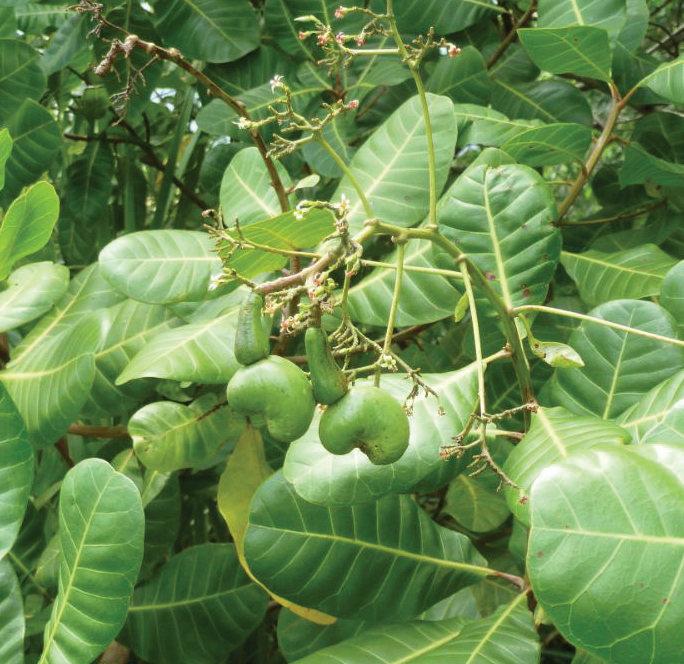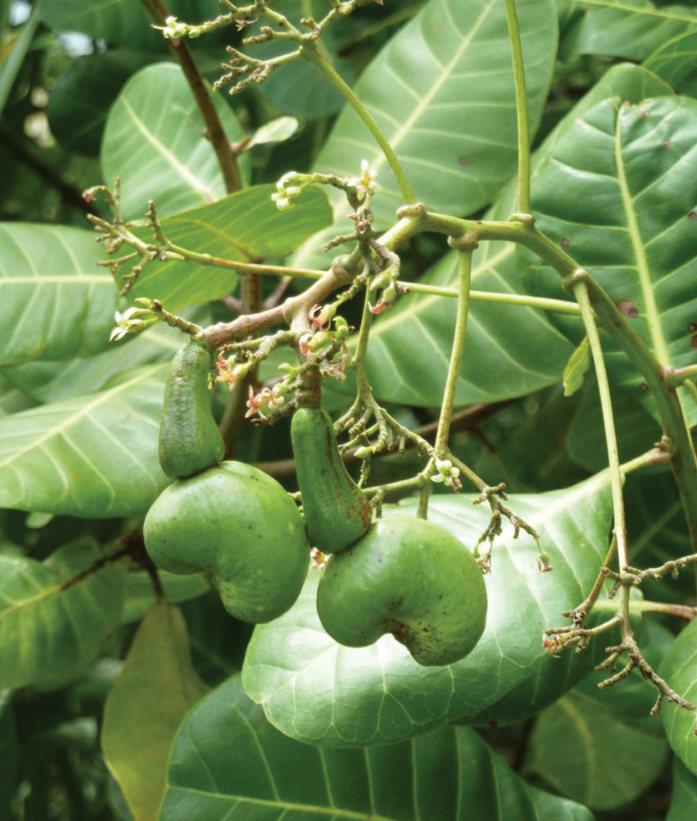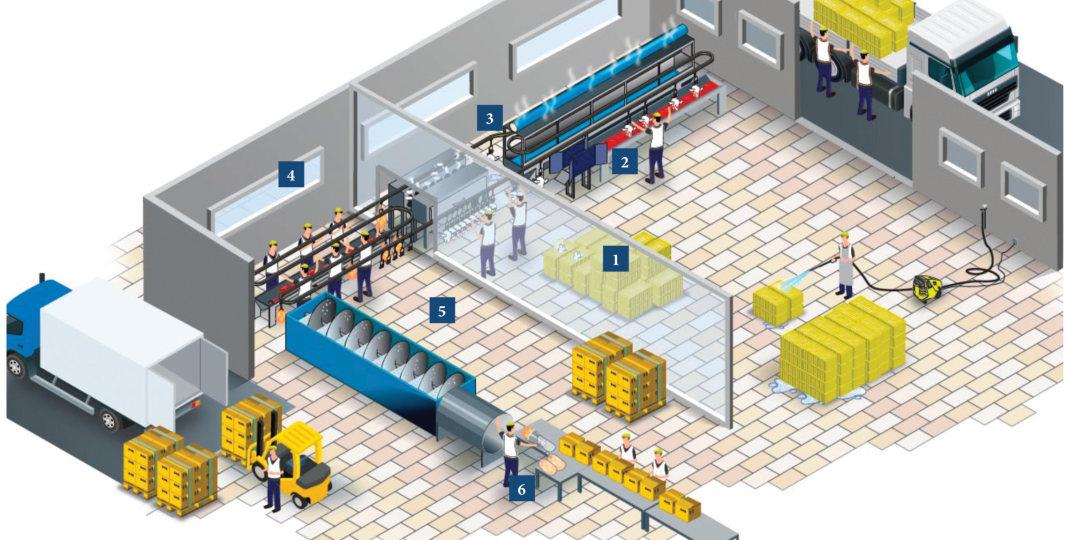
11 minute read
CONTENTS
Protecting cashew nut trees from diseases
Tropical tree crops typically suffer a range of diseases which affect leaves, fruit, branches, trunks and roots, and cashews are no exception. Dr Terry Mabbett reports.
FOR A LONG time cashew (Anacardium occidentale) was a niche crop but is now mainstream with cashew nuts a highly valued export commodity for an increasing number of countries. Main peculiarity of the cashew tree is bearing true fruit (the nuts) which look and feel like true seed. However, the cashew nut is the botanically defined fruit which develops from a soft-tissue receptacle (the so-called accessory fruit) and which can easily be mistaken for a true fruit.
The cashew tree Cashew is an evergreen tree in the plant family Anacardiaceae and cultivated for its cashew nuts. Trees are fast growing and spreading with prolific branching from the main trunk to form a characteristically dome-shaped canopy or crown. Foliage is thinly borne and essentially limited to leaves on the ends of branches. Individual leaves are borne on petioles (leaf stalks) with a swollen base. They are ovate in shape, leathery and shiny dark green in colour. Leaf surface is smooth with a thick waxy cuticle and pronounced midrib and main veins.
The numerous flowers are borne in panicles at the ends of branches. Inflorescences consist of male and hermaphrodite, scented flowers, creamcoloured when they open before turning pink to red. Fertilised flowers develop into the kidney-shaped true fruit (the nut) which is about 3 cm long with a grey-brown shell. This true fruit which looks and feels like a seed is inserted into a fleshy receptacle commonly called the ‘cashew apple’. Indeed when detached from the fleshy receptacle the classic kidney shape of the hard cashew nut means it could easily be mistaken for a ‘bean’ – the true seed of many leguminous plant species. Cashew apples are pear shaped, thinskinned and red to yellow in colour.
Cashew apple is rich in Vitamins A and C and is utilised in producing countries to make a variety of food and drink including preserves, chutney, vinegar and alcoholic drinks. Trees can grow to a maximum height of up to 12m with an economic lifespan of 25 years, after which they are replaced in commercial plantings.
Cashew is native to northern South America, Central America and the Caribbean islands but is now naturalised throughout the lowland tropics. Cashew was first introduced into Mozambique and then India in the sixteenth century by Portuguese explorers and traders for planting in coastal regions to mitigate erosion. Cashew was subsequently spread within these countries with the aid of
Image credit: Terry Mabbett
Ovate to oblong shaped leaves are leathery and shiny with prominent midrib and main veins.
elephants which ate the bright cashew apples along with the attached nuts. The nut was too hard to digest and later expelled with the droppings. It was not until the nineteenth century that cashew estates and plantations were planted around the world. The cashew tree may well be a New World native but cashew is now cultivated throughout the tropics with three of the world’s top five producers - Vietnam, India and Philippines - in Asia.
As a member of the plant family Anacardiaceae, the cashew tree has some interesting and well-known relatives including highly useful ones like mango (Mangifera indica) and pistachio (Pistacia vera), but also some potentially poisonous ones like poison ivy (Toxicodendron radicans) and poison oak (Toxicodendron diversilobum).
Cultivation, yield and production A typical cashew tree will begin to bear fruit in its third or fourth year with tree maturity and maximum fruit yield attained by the seventh year, provided conditions are conducive to good growth. Average yield of cashew nuts from mature trees is seven to 11kg per tree per annum. Trees can live for more than 50 years but most will only yield for up to 20 years.
Cashew is truly tropical in origin, distribution and growing conditions. Required temperature is typically between 24°C and 28°C. Trees are frost-prone and rapidly killed by extended periods of low temperature. Optimal growth occurs in deep, well-drained soils and within an extended range of soil pH (4.2 to 8.7). However, cashew will establish and grow in sandy, poorly-fertile soils and where other fruit trees will not survive. As such cashew is entirely suitable for soil erosion control plantings along coastal areas.
Cashew has traditionally been propagated from mature seeds which are sown directly into the final planting position or into seed beds or polybags in a nursery with well-grown seedlings subsequently used for transplanting. Suitability of seeds for sowing can be gauged by immersing in water with only those which sink, selected for sowing. Cashew can be propagated from stem cuttings and significant improvements can be obtained by selecting seed for high yield and then propagating these selections by cuttings.
More recently, plant breeding establishments around the world and notably the Kerala Agricultural University

Image credit: Terry Mabbett
During reproductive development the cashew nut (true fruit) reaches its full size long before the cashew apple (receptacle or accessory fruit) has grown to reach full dimensions.
(KAU) in southern India have produced a range of modern, high-yielding varieties with ‘Priyanka’ and ‘Amrutha’ among the most recent from KAU. Benefits include early flowering, good response to fertiliser and nutrient application and the production of large, high-grade cashew nuts. These varieties are propagated by softwood grafting.
Newly emerged tree seedlings should be grown-on under a shade level of approximately 50% and then hardened off in direct sunlight prior to planting in final positions in the field. Cashew seeds have a notoriously poor germination rate which means two to three seeds should be sown per planting hole and subsequently thinned out as necessary. Thinning should leave seedlings at a final minimal spacing of 12m between plants in the row and another 12m between rows. Some plantations prefer a wider spacing up to 15m x 15m.
Young growing trees should be irrigated to assist establishment but mature trees can survive dry periods because of the tree’s extensive root systems which is able to access moisture from deep in the soil profile. Cashew requires about 750mm rain per annum but its tolerance over extended dry periods (up to six months) is facilitated by the tree’s wide-ranging root system. However, this ability to withstand drought may be lost if trees are planted too close together.
A weed free area should be maintained around the base of the tree trunk to prevent weed competition for both water and nutrients especially when trees are young and not completely established. Cashews require minimal pruning and restricted to the removal of those branches which may impede the movement and use of machinery in commercial plantations, and only carried out once the tree is six-years-old.
Harvesting and use of cashew nuts require a meticulous operation to avoid severe body reaction and poisoning caused by highly toxic cashew oil which is contained in the freshly harvested nuts. Farmers and others must not attempt to break open cashew nuts (fruit) straight after harvesting because the kernel (seed) inside contains toxic oil. If touched, this oil is capable of causing an itchy rash of the skin and moreover painful blisters in the mouth if the contents of fresh cashew nuts are eaten. Cashew nuts must be dried for several days and then roasted before being cracked open.
Image credit: Terry Mabbett

Ripe and mature cashew nut inserted in the full-size, rose-coloured cashew apple.
Anthracnose disease follows the cashew tree Tropical tree crops typically suffer a range of diseases which affect leaves, fruit, branches, trunks and roots, and cashews are no exception. However, as with other tropical fruit tree crops, including mango, avocado and citrus, some diseases have managed to follow the dissemination and distribution of cashew from its New World roots and into tropics-wide commercial crops. For cashew the pathogen is the fungus Colletotrichum gloeosporioides, which causes the disease commonly known as anthracnose.
Anthracnose is the most widespread and damaging disease of cashew. Wherever cashew is grown this disease is a problem, and not surprising since the same fungus causes the ‘same’ disease in a wide range of other tropical fruit tree crops, including mango, avocado and papaya. Symptoms of anthracnose are water-soaked lesions on the leaves, twigs, flowers and young cashew apples, and which subsequently develop into orange-brown or red lesions. Other wide ranging and specific symptoms include black spots on the inflorescences, abortion of the flowers and black lesions on the nuts.
Anthracnose disease is favoured by high rainfall and high humidity, the very conditions experienced in a typical cashew growing region for at least part of the year. Anthracnose disease of cashew is controlled by using protectant sprays of a copper-based fungicide such as cuprous oxide, applied to disease susceptible parts of the plant. Whole canopy foliar sprays of cuprous oxide fungicide should be applied when flower buds begin to expand and subsequently repeated through to fruit set. Good spray deposit coverage before onset of the rainy season is essential to protect against this disease which thrives when there is surface water on leaves and other plant parts and simultaneously with extended periods of high humidity. Pink disease in cashew, just one host among many Pink disease is another widespread and potentially serious disease of cashew, caused by a basidiomycete fungus, recently renamed Phanerochaete salmonicolor, having previously been called Erythricium salmonicolor, and before that Corticium salmonicolor. Irrespective of its scientific name this fungal pathogen is responsible for a seriously damaging disease of the branches. The disease initially shows as white patches on the bark and subsequently, as silky, white film of fungal mycelium during the monsoon or rainy season. Later formed salmon-pink-coloured fungal growth represents the advanced stage of infection and disease development, with affected bark splitting and peeling from the branches and affected shoots dying back from the tips.
Pink disease is notoriously difficult to control partly because it affects so many other trees – rubber, cocoa, coffee, tea, citrus, mango and nutmeg, thus making cross-infection between different tree crops a major concern for growers. Best initial response is prompt cultural control by frequent pruning of the affected shoots and branches. The cut is made behind the infected area and ideally when the disease is at its earliest stages, followed by burning of the pruned off branches.
However, to be anywhere near effective, pruning should be carried out in conjunction with use of a fixed copper fungicide such as cuprous oxide. Exposed cut ends of the branches should be sealed with a ‘canker paint’ containing cuprous oxide. And by also carrying out prophylactic spraying of the trees with cuprous oxide fungicide before the onset of the monsoon or rainy season, and again when the wet season period has ended.
Damping-off disease in the cashew nursery Poor drainage causing excessively wet and humid conditions in the nursery can cause severe loss of seedling trees from dampingoff disease, caused by the wet-loving fungus-like pathogens Phytophthora species and Pythium species. The delicate, recentlyemerged seedlings are easily killed by these pathogens, which infect both the stem/root collar region and the root system. Effective control is achieved by watering the seedling beds or polybags with a suspension of cuprous oxide as a wettable powder or water dispersible granule formulation in water. ■
Dutch Poultry Tech releases videos to operate its equipment

THE PANDEMIC HAS restricted travel, delaying the installations and services of the poultry processing equipment. To overcome this unprecedented challenge, Dutch Poultry Tech BV has come up with instructional videos dubbed pluck&play solutions.
The video database offers access to inhouse knowledge of installation, maintenance and operational guidance as well as instructions for the technical staff. They show how to install, maintain, finetune and clean the automatic processing equipment.
The company has put its knowledge in the design of the machines and made the videos’ available for the user.
“Our knowledge is in the design of the machines and with our instruction video’s you have the NEW NORMAL: access to in-house knowledge of installation, - maintenance and operation,” says CEO Robert Seijffert
For example, the Dutch Poultry Tech’s gizzard harvester: Every equipment supplier uses all kind of chain-driven technology, to drive the transport chains, sprockets, in-feed rollers, etc. This same method is being used since 1980 and never re-engineered. However, in Dutch Poultry Tech’s gizzard harvester, the company has removed all old-fashioned chainand-sprockets drive systems and powered each process by an electric motor.
The videos provide instructions on how to maintain and install the poultry equipment.
“We provide quick and swift feedback, and you will not be delayed in this uncertain Corona time. No overpaid European Engineers, running around, to install and connect your processing equipment because the machines are pluck&play®,” Mr Seijffert added.
Who is Dutch Poultry Tech? Dutch Poultry Technology is a Dutch manufacturing and engineering company specialised in the design, manufacturing and installation of cost-effective, reliable and easy to install and operate poultry processing solutions for processing 250 up to 6000 birds per hour. Its semi- and fully automatic processing solutions are based on proven technology and more than 30 years of automatic processing experience. Lean engineering and manufacturing significantly reduce production, installation and operation costs. The company based its experience on years of reconditioning machinery from A-brand OEMs. ■
For more information, please visit: www.dutch-poultry-tech.com







